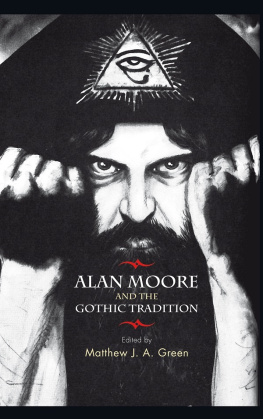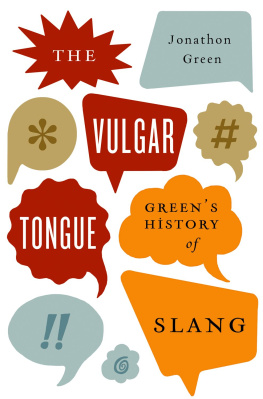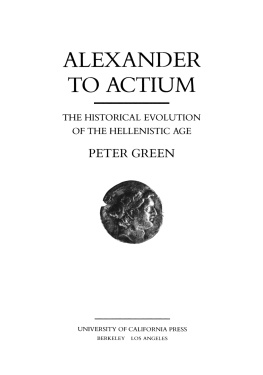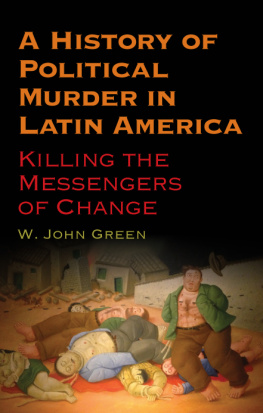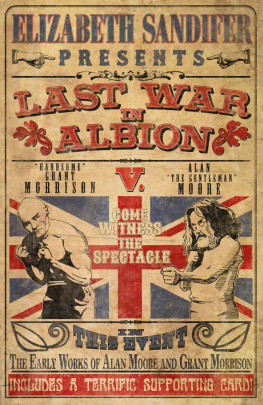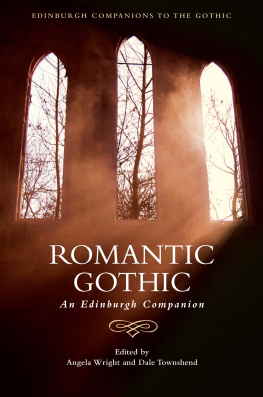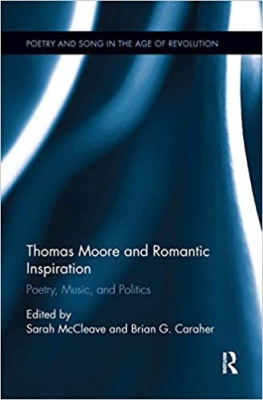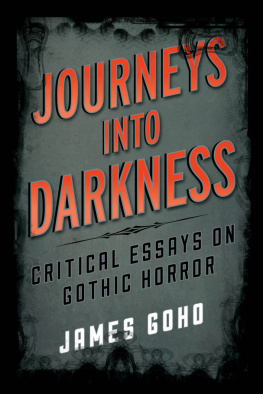Alan Moore and the Gothic tradition

Alan Moore and the Gothic tradition
Matthew J. A. Green
Manchester University Press
Manchester and New York
distributed in the United States exclusively
by Palgrave Macmillan
Copyright Matthew J.A. Green 2013
The right of Matthew J.A. Green to be identified as the author of this work has been asserted by him in accordance with the Copyright, Designs and Patents Act 1988.
Published by Manchester University Press
Oxford Road, Manchester M13 9NR, UK
and Room 400, 175 Fifth Avenue, New York, NY 10010, USA
www.manchesteruniversitypress.co.uk
Distributed in the United States exclusively by
Palgrave Macmillan, 175 Fifth Avenue, New York,
NY 10010, USA
Distributed in Canada exclusively by
UBC Press, University of British Columbia, 2029 West Mall,
Vancouver, BC, Canada V6T 1Z2
British Library Cataloguing-in-Publication Data
A catalogue record for this book is available from the British Library
Library of Congress Cataloging-in-Publication Data applied for
ISBN 978 0 7190 85994 hardback
First published 2013
The publisher has no responsibility for the persistence or accuracy of URLs for any external or third-party internet websites referred to in this book, and does not guarantee that any content on such websites is, or will remain, accurate or appropriate.
Typeset by Action Publishing Technology Ltd, Gloucester
Contents
Every effort has been made to contact copyright holders.
Reference format
References to all works in the comics medium employ the following format: volume or book (V or B followed by the appropriate Arabic numeral; e.g. V1, B5), chapter (upper-case Roman numeral), page number (Arabic numeral) and panel number (lower-case Roman numeral), as in the following examples:
reference to V for Vendetta, Book 1, Chapter 4, page 4, panel 7: B1.IV.4.vii.
reference to From Hell, Chapter 4, page 35, panel 4: IV.35.iv.
Panel numbering runs from left to right across the page and then down; where panels do not follow a standard grid, the most likely direction of reading the page has been followed. Where any of the above divisions is not present, the relevant digit has been omitted (as in the example of From Hell above, which has chapter divisions but not book or volume divisions).
Chapter and issue numbers
Chapter numbering has replaced original issue numbers where these are the same, as in the case of Watchmen, or where the original publication included the same chapter divisions as the collected edition (e.g. V for Vendetta and From Hell). Where chapter numbers differ from issue numbers, as in the case of Swamp Thing, references cite the original magazine publication with corresponding references to the trade paperback collection provided in the bibliography. Chapters in V for Vendetta do not consistently begin on the page where the chapter number and title are given; readers of the collected editions are advised, however, that chapter breaks are indicated by a small Guy Fawkes mask in the bottom outside corner of each chapters final page.
Pagination
Pagination is by issue/chapter, excluding any pages that included advertisements in the original magazine publications. Where no pagination is provided, numbering begins on the page in which the narrative or prologue begins, excluding cover reproductions. Where the trade paperback collection includes continuous pagination across multiple issues/chapters (as with collected editions of Swamp Thing and V for Vendetta), non-continuous pagination is retained in view of the considerable variation in practice across different editions. Interpolated material that is included at the end of a volume/issue/chapter (e.g. Under the Hood in Watchmen) is also paginated separately and, where given, follows the pagination as presented in the cited text.
Editions
For the majority of these works, no standard edition exists and reference is, in general, given to the trade paperback or hardback collection most readily available when this book went to press.
Quotations
Ellipses: given the preponderance of ellipses in Moores comics, it has been necessary to differentiate their presence in the original texts from editorial omissions made when quoting from these. Across all quotations, ellipses that appear enclosed in square brackets [] indicate editorial omissions, while those that appear without brackets are present in the original.
Line breaks in block quotations indicate a full or partial break in a speech balloon, either in the same panel or split across panels. In short quotations, line breaks are indicated by a forward slash: / .
Lettering: in general, the typescript for quotations has been standardised and there has been no attempt to replicate changes in letter-weighting. Practice varies across scholarly publications in the discipline. It was felt that because the gradations possible in comics are not possible in conventional typesetting and because discerning such weightings involves considerable subjectivity whilst yielding little change in the overall sense of the quoted material, this would be the most practical approach to take; however, where emphasis is clearly fundamental to the sense of the passage as in the case of underlining, a change in font, or changes in capitalisation these are indicated in the quotations.
For Thomas who gets first dibs on the Swamp Thing collection
Michael Bradshaw is the author of Resurrection Songs: the Poetry of Thomas Lovell Beddoes (2001), the co-editor of The Ashgate Research Companion to Thomas Lovell Beddoes (2007), the editor of Deaths Jest-Book: the 1829 text (2003) and the co-editor of Beddoess Selected Poetry (1999). He has published critical articles on a range of Romantic authors and themes, including George Darley, Thomas Hood, John Keats, Mary and Percy Shelley, Walter Savage Landor, The London Magazine and Romantic fragment poems. Currently writing on Hoods comic poetry, and on Romanticism and disability, he is Professor of English at Edge Hill University, Liverpool.
Jochen Ecke teaches English literature at the Johannes Gutenberg University, Mainz, Germany. He has written his Masters thesis on concepts of time and space in Alan Moores works and is currently preparing his doctoral thesis on British comics of the 1980s. In addition to co-editing Comics as a Nexus of Cultures (), he has published a number of essays on Alan Moore and Warren Ellis. He has also done extensive work in the German comics industry, serving as German editor and occasional translator on works by Ed Brubaker, Greg Rucka and Alan Moore.
Laura Hilton holds a Ph.D. in English Literature from the University of Birmingham, where she also completed her BA and MA degrees. Her doctoral research analyses representations of the Gothic double in the contemporary graphic novel and focuses on the work of Neil Gaiman, Frank Miller and Alan Moore. She is co-founder and co-editor of the first two issues of the Birmingham Journal of Literature and Language (BJLL) and has recently published articles in Gothic Science Fiction: 19802010 and Investigating Heroes: Truth, Justice and Quality TV. She also has an article forthcoming in Comment Rver la Science-fiction Present?

